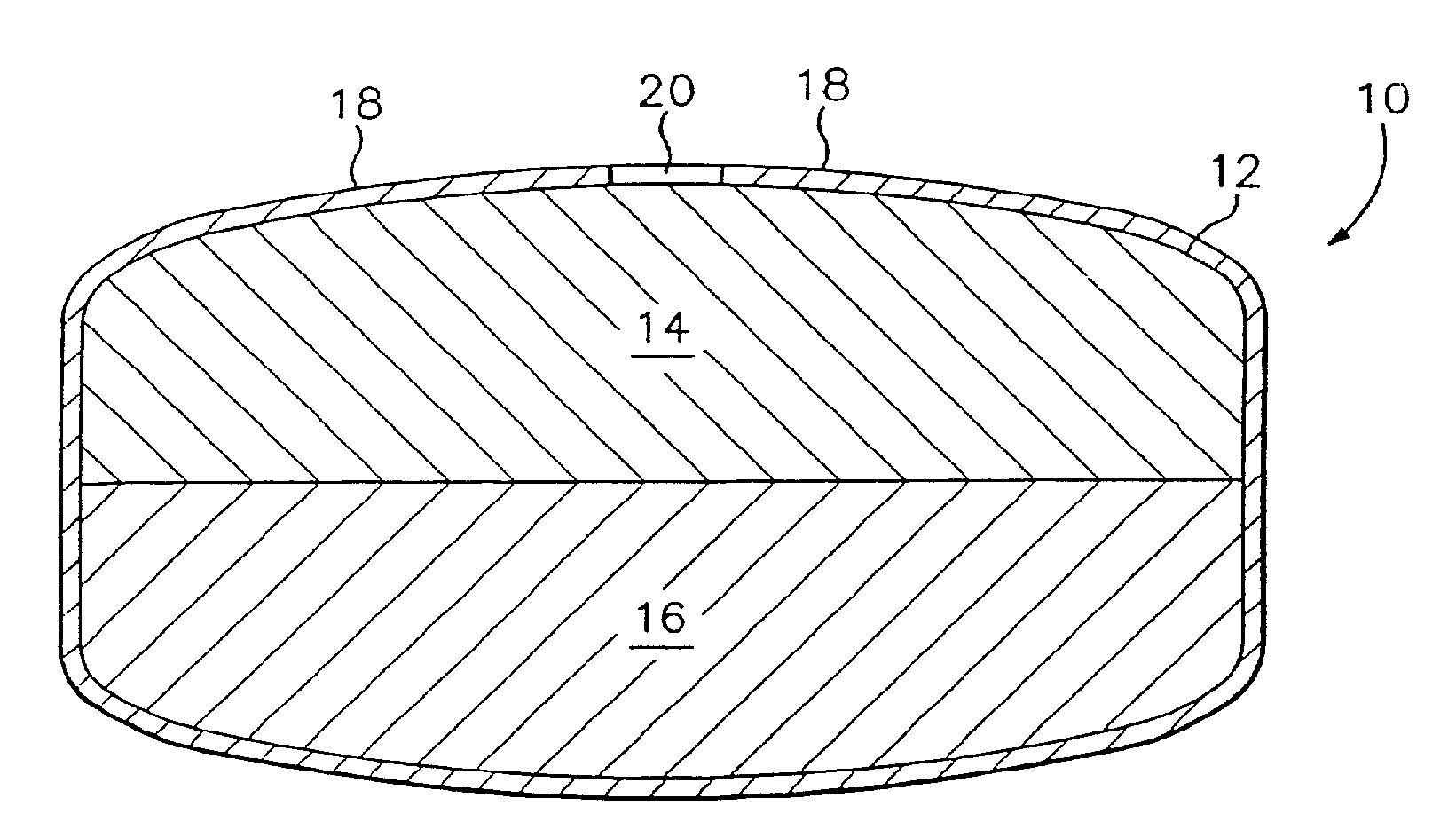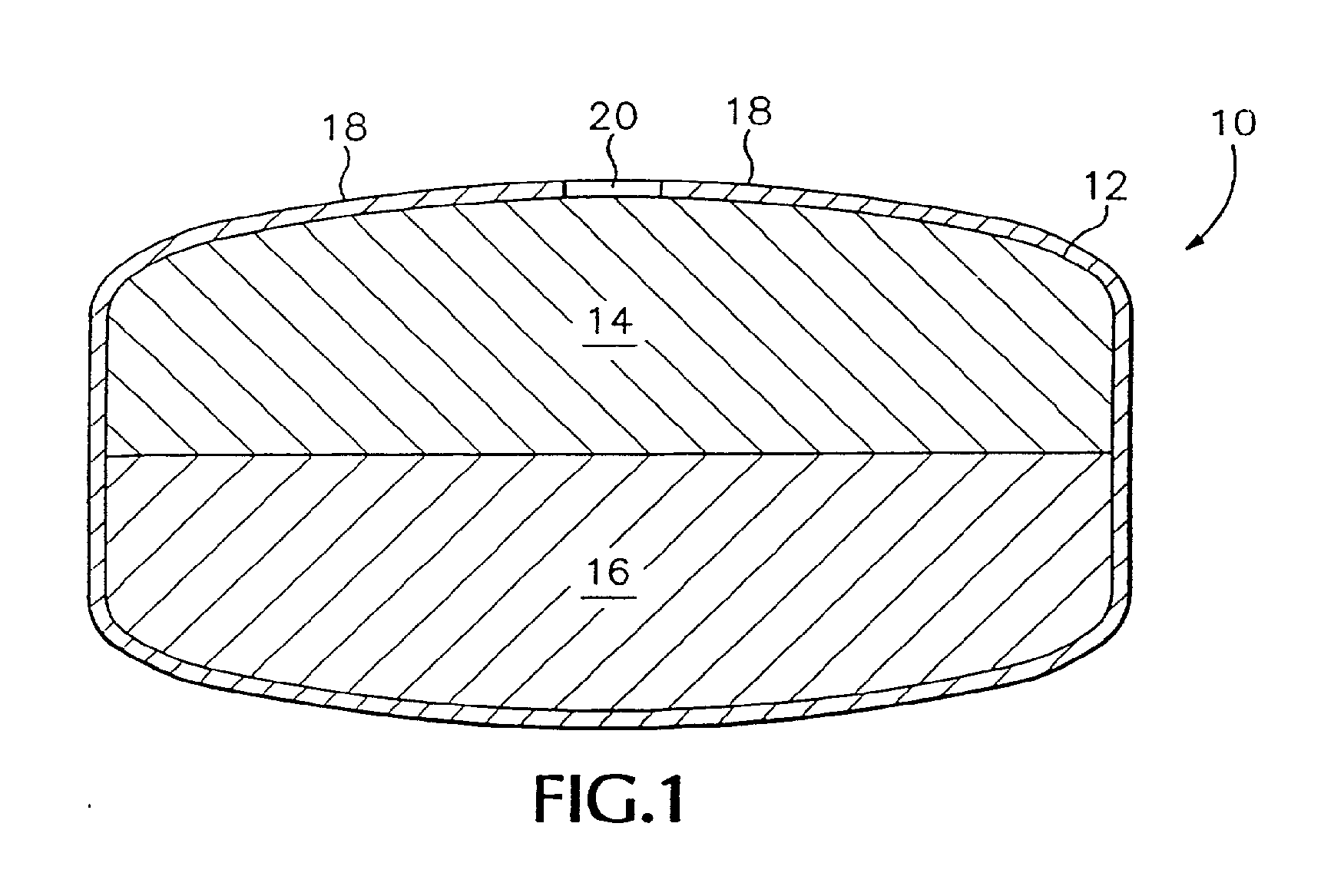Hydrogel-driven drug dosage form
a technology of hydrogels and tablets, applied in the field of dosage forms, can solve the problems of drug not being available, residual drug left in the tablet interior, drug residues not being absorbed, etc., and achieve the effects of reducing residual drug amount, reducing drug loading, and improving drug efficiency
- Summary
- Abstract
- Description
- Claims
- Application Information
AI Technical Summary
Benefits of technology
Problems solved by technology
Method used
Image
Examples
example 1
[0093]Exemplary dosage forms of the present invention were made with a bi-layer core geometry of the type depicted in FIG. 1. The bi-layer core consisted of a drug-containing composition and a water-swellable composition.
[0094]To form the drug-containing composition the following materials were blended (see Table A): 35 wt % of the citrate salt of 1-[4-ethoxy-3-(6,7-dihydro-1-methyl-7-oxo-3-propyl-1H-pyrazolo[4,3-d]pyrimidin-5-yl)phenylsulphony]-4-methylpiperazine for treatment of penile erectile disfunction, also known as sildenafil citrate (hereinafter referred to as Drug 1) having a solubility of about 20 μg / mL at pH 6, 30 wt % xylitol (trade name XYLITAB 200), 29 wt % PEO with an average molecular weight of 600,000, 5 wt % sodium starch glycolate (trade name EXPLOTAB), and 1 wt % magnesium stearate. The drug-containing composition ingredients were first combined without the magnesium stearate and blended for 20 minutes in a TURBULA mixer. This blend was pushed through a screen (...
example 2
[0099]This example demonstrates the inventive delivery of a high dose of Drug 1 from bi-layer tablets by increasing the amount of drug in the drug-containing composition. For the tablets of Example 2, the drug-containing composition consisted of 56 wt % Drug 1, 20 wt % XYLITAB 200, 19 wt % PEO with an average molecular weight of 600,000, 4 wt % EXPLOTAB, and 1 wt % magnesium stearate. The water-swellable composition consisted of 74.5 wt % EXPLOTAB, 25 wt % PROSOLV 90, and 0.5 wt % magnesium stearate. These tablets were made as in Example 1, except that 500 mg of the drug-containing composition was used to make the tablet. See Table C for further details of the make-up of the tablets. The drug-containing composition and water-swellable composition for this example were combined in a ratio of 83.3 wt % drug-containing composition to 16.7 wt % water-swellable composition. Dissolution tests were performed as described in Example 1. Results are shown in Table 2 and summarized in Table D....
examples 3a-3b
[0101]These examples demonstrate the inventive delivery of various drugs from bi-layer tablets. For the tablets of Example 3A, the drug-containing composition consisted of 35% sertraline HCl (Drug 2) having a solubility of 0.2 mg / mL at pH 7, 30 wt % XYLITAB 200, 28.75 wt % PEO with an average molecular weight of 600,000, 5 wt % EXPLOTAB, and 1.25 wt % magnesium stearate. The water-swellable composition consisted of 74.5 wt % EXPLOTAB, 25 wt % PROSOLV 90, and 0.5 wt % magnesium stearate. These tablets were made as in Example 1. Dissolution tests were performed on these tablets in the same manner as Example 1 except the residual drug was analyzed by HPLC using a Phenomenex Ultracarb 5 ODS 20 column. The mobile phase consisted of 35 vol % TEA-acetate buffer (3.48 mL triethanolamine and 2.86 mL glacial acetic acid in 1 L HPLC H2O) in acetonitrile. Drug concentration was calculated by comparing UV absorbance at 230 nm to the absorbance of sertraline standards. The results are presented i...
PUM
| Property | Measurement | Unit |
|---|---|---|
| wt % | aaaaa | aaaaa |
| solubility | aaaaa | aaaaa |
| solubility | aaaaa | aaaaa |
Abstract
Description
Claims
Application Information
 Login to view more
Login to view more - R&D Engineer
- R&D Manager
- IP Professional
- Industry Leading Data Capabilities
- Powerful AI technology
- Patent DNA Extraction
Browse by: Latest US Patents, China's latest patents, Technical Efficacy Thesaurus, Application Domain, Technology Topic.
© 2024 PatSnap. All rights reserved.Legal|Privacy policy|Modern Slavery Act Transparency Statement|Sitemap


